A Film Review:
On Healing Land, Birds Perch/
Dat Lành, Chim Dau
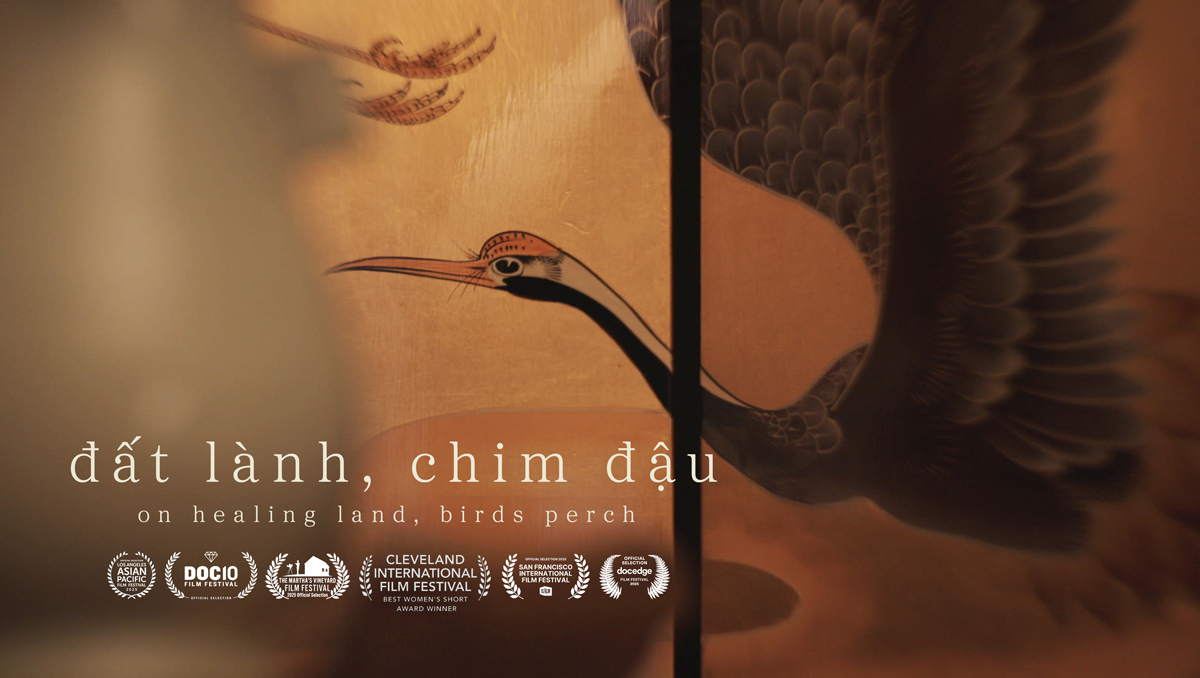
By Marc Yablonka
When the late Associated Press photographer Eddie Adams shot the horrifically iconic, Pulitzer Prize-winning image of ARVN Gen. Nguyen Ngoc Loan shooting Viet Cong Capt. Nguyen Van Lem at point blank range in the head with a Smith & Wesson .38 on the streets of Saigon during the Tet Offensive in 1968, Adams was known to feel that not just one, but two lives were ruined on that day thanks to his photo.
He would never know that 50-years after the fall of Saigon on April 30th, 1975, a documentary film would be made, not only to revisit the indelible moment the picture was taken and its aftermath, but to seek out those most immediately affected by that moment: the daughter of Gen. Loan, June Nguyen; the children of VC Captain Lem, Loan and Thong Nguyen; and the lone survivor of the equally horrific assassination of the family of Lt. Col. Tuan Nguyen, Rear Admiral Huan Nguyen, USN.
The film’s title, On Healing Land, Birds Perch/Dat Lành, Chim Dau, from a proverb attributed to Emperor Le Loi during the Le Dynasty (1428-1527), is an appropriate title for a 30-minute documentary that explores the possibility that members of the three families whose lives were affected by the shooting of Capt. Lem might one day find a sense of healing from what their parents experienced that fateful day. Stirring, tearful, soul-searching, and gut-wrenching are adjectives that come to mind.
The film’s co-producers, Naja Pham Lockwood and Julian Cautherley, in Pham Lockwood’s directorial debut, reveal, “For the first time on camera the intense emotions this photo elicits even today and the impact it has had on their lives. While these individuals hold widely differing views on this photo, the film poignantly portrays that all have something in common: the lasting trauma from the War.”
“We worked very hard not to promote violence in the film, but we had to show the photo,” Pham Lockwood said.
Pham Lockwood traces her transition from Investment Banking (she majored in the field at Harvard University), to documentary filmmaking, to being named Arts Commissioner in San Francisco by former Mayor Willie Brown and Governor Gavin Newsom, during which she secured funding for the Asian Art Museum in the city. When her family moved to Park City, Utah, she was asked to be on the local board of the Sundance Film Festival.
“That was where I saw the power of storytelling. I started off as an executive producer, finding money and investors for films. On Healing Land, Bird Perch is my vision. For the 50th Anniversary [of the end of the Vietnam War] I really wanted to tell a story from the perspective from both sides of the Vietnamese,” she told the Sentinel.
As a youth, Pham Lockwood was repeatedly haunted by the horror of Adams’ photo—War’s anniversary after War’s anniversary after War’s anniversary.
“Every year, starting in `75 when I came here, I would always see that photo during the anniversary of the end of the Vietnam War. I was traumatized. My whole room was lit up so that I could sleep,” she said.
Pham Lockwood’s father, who had worked in Intelligence for USAID during the war, did his best to assuage Naja by telling her that Gen. Loan was not the terrible man the media had made him out to be, which resulted in a deportation hearing.
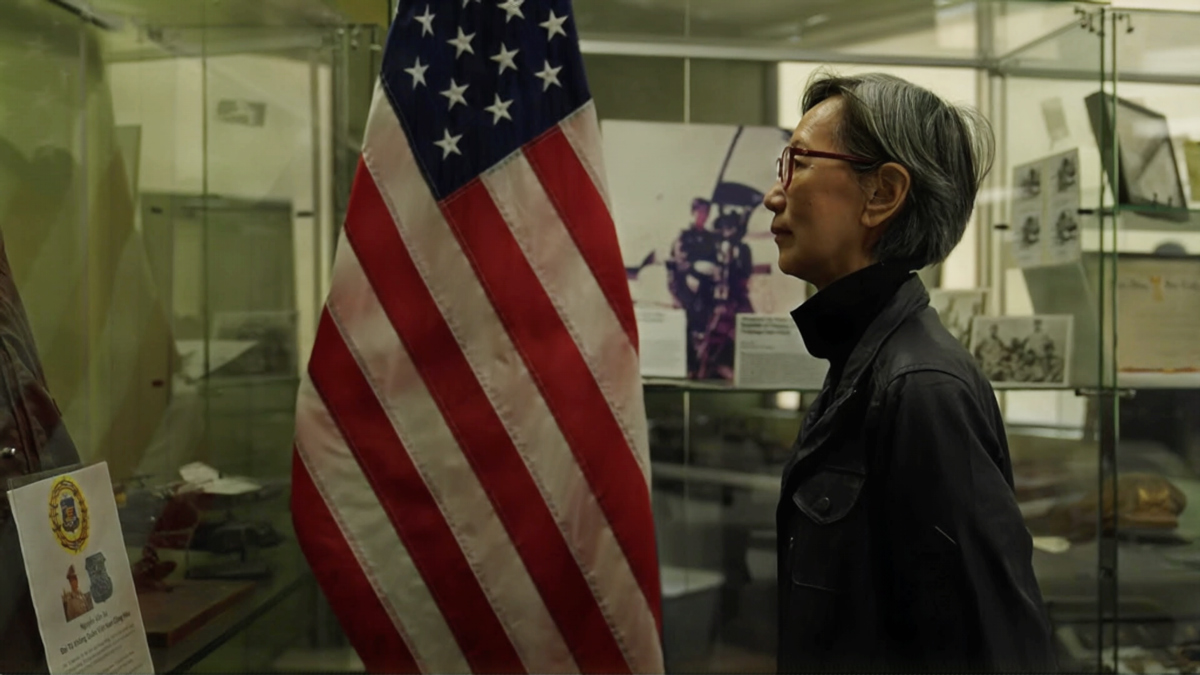
June Nguyen, daughter of Brig. Gen. Ngueyn Ngoc Loan viewing exhibits at the Museum of the Republic of Vietnam, Little Saigon, California (Photo courtesy Naja Pham Lockwood)
Regarding that hearing, no doubt influenced by the media and public opinion, in 1978, “the Immigration and Naturalization Service contended that the summary execution of Nguyen Van Lem had been illegal by Vietnamese law. In an attempt to revoke his [Nguyen Ngoc Loan’s] permanent resident status to ensure that he could not become a United States citizen, they approached Adams to testify against Loan, but Adams instead testified in his favor and Loan was allowed to stay. The deportation was halted by the intervention of United States President Jimmy Carter, who stated that `such historical revisionism was folly,’” according to www.Wikipedia.com.
Meanwhile, to further put her at ease about the photo of Loan and Lem, Pham Lockwood’s father would add, “There’s this boy whose family was assassinated. He’s alive and he’s living somewhere in the US.” in reference to Nguyen Huan, the sole survivor of the family that the VC allegedly assassinated. That of Lt. Col. Nguyen Tuan, an officer of the armored forces of the ARVN.
In his wisdom, her father also counseled her not to pass judgement on someone who takes the life of another during war time.
Pham Lockwood was asked why Eddie Adams photo haunted her more than two other iconic photos snapped during the war, also taken by AP photographers. One being Nick Ut’s photo of nine-year old Phan Thi Kim Phuc running naked from her Cao Dai village of Trang Bang during a napalm attack. The other being Malcolm Browne’s photo of the Venerable monk Thich Quang Duc immolating himself outside a Buddhist temple in Cho Lon, the Chinese quarter in Saigon. While admitting the other photos were horrific, Pham Lockwood emphasized, “Eddie’s photo was so grizzly!”
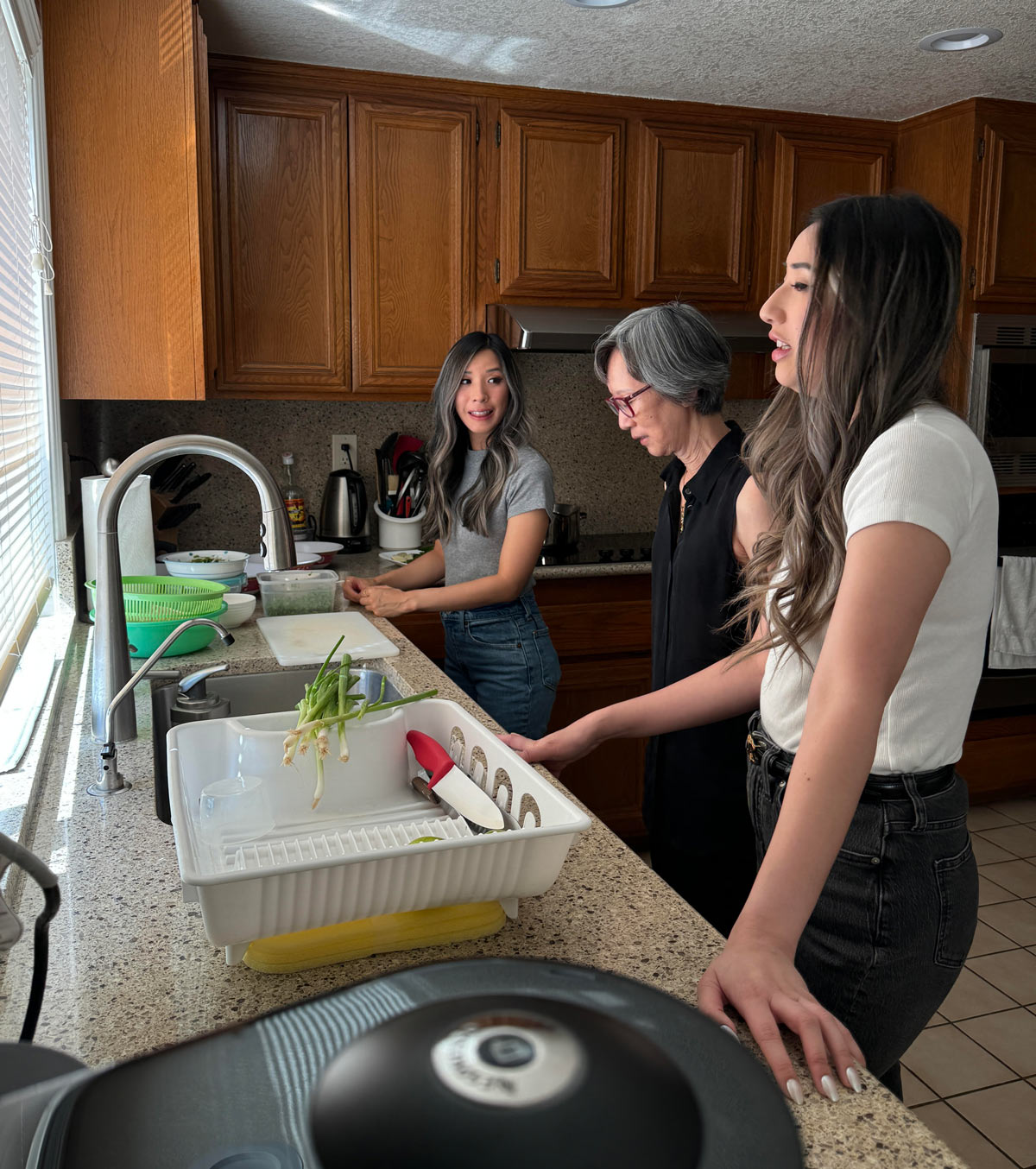
June Nguyen, daughter of Brig. Gen. Nguyen Ngoc Loan, preparing a meal at home with her daughters (Photo courtesy Naja Pham Lockwood)
It was also the fact that it was one Vietnamese killing another Vietnamese, according to Pham Lockwood. “It’s brothers killing brothers for me. To see Vietnamese in such a brutal way was shocking.”
“People have asked me, ‘Does that mean you think the Vietnamese story is more important that the Vietnam veterans’ story? Absolutely not! I think it adds to their story. It’s only when we see perspectives of all sides, and understand each other beyond borders, and understand each other, that we actually move beyond the war, our trauma, and our tragedy,” she said.
In the film, June Nguyen, Gen. Loan’s daughter, reveals that when, as a young girl. she first saw the photo of her father shooting the VC, she was horrified. In school, when the photo was brought up, she was chastised by her classmates. But as the years went on, she knew her father to be the loving, caring father that, to her, he always was.
Meanwhile the daughter and son of Nguyen Van Lem, Nguyen Loan and Nguyen Thong, swore through tears, not only was their father not the assassin of Lt. Col. Tuan, but that the Viet Cong were not involved in the murder at all.
For his part, US Navy Rear Admiral Nguyen Huan, who harbors guilt to this day since he went outside and came back in [a bad omen during Tet] because superstition holds that the first person to enter a house during the New Years holiday should be wealthy and healthy. For that reason, Huan’s father slapped him, and he feels he brought bad luck upon his family. Through the bitterest of tears, he recalls the moment of his family’s assassination, and the fact that he is alive today because he hid behind sandbags while the siblings whom death forbade from growing old like him are not.
Pham Lockwood is the first Vietnamese-born American to tell the story of Adams’ photo from both sides. Compelled to include her own family’s story as it relates to how she came to be the director of On Healing Land, Birds Perch, she describes herself and her family thusly:
“I am the daughter of South Vietnamese, the last generation [to have been born in Vietnam by the end of the war]. At least for them, and for my parents, I think it’s very similar to the Jewish Holocaust, where they came to America. They didn’t have time to grieve. They didn’t have time to deal with their trauma. Now, as an adult, I realize that. They were just so busy trying to survive in a new country. It’s the children of that generation that are telling the stories,” she said.
She echoes the oft-told generational occurrence in most cultures of children growing up not knowing what their parents had suffered before immigrating to the US.
“We never talked in my family about the war. My family was so focused on making sure their kids were Americans and that we had the best opportunities. They were very focused on moving forward, making sure their kids spoke fluent English and were able to fend for themselves in a new country. We grew up knowing that we would never go back to Vietnam, and that we are Americans,” she added.
From their first Thanksgiving in Boston, where Pham Lockwood and her siblings grew up, they were completely taken aback by how inclusive the community was.
“I give back and my family gives back because we were given. America really opened its arms. We were so grateful those first few years,” Pham Lockwood recalled.
To Pham Lockwood, Admiral Nguyen Huan shares the same fate. Thanks to America, she feels, “He is that bird [in On Healing Land, Birds Perch]. He is able to rest a long time and find home in a place that is a good land, a fertile land of peace. That’s his journey. He hopes for peace everywhere in the world,” she said.
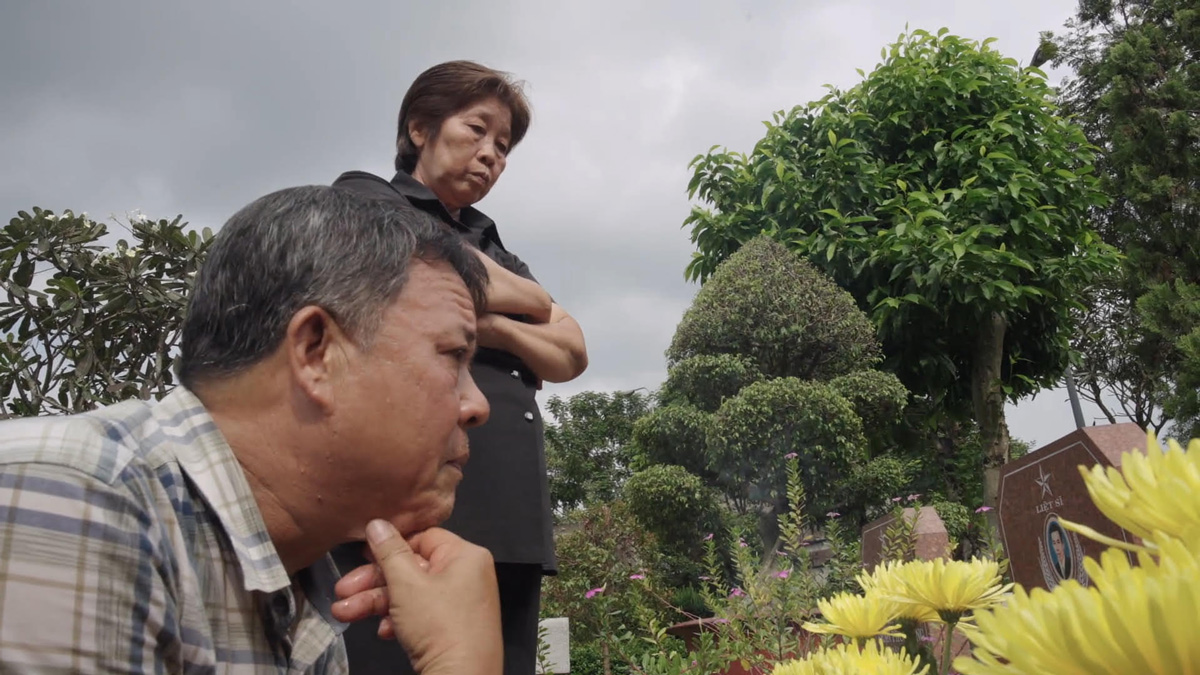
Loan and Thong Nguyen, children of the VC Capt. Nguyen Van Lem, looking at their father’s tombstone, Saigon (today Ho Chi Minh City), Vietnam (Photo courtesy Naja Pham Lockwood).
Gen. Loan’s family has found their sense of peace over Adams’ photo. Growing up, his children harbored anger towards Adams, according to Pham Lockwood. But since they’ve grown up, they have come to appreciate the late photographer and the deep friendship he had with their father, solidified by the fact that Adams was present at the general’s funeral.
Once, when Adams expressed regret, the general told him, “If it wasn’t you, it would have been someone else who would have taken the photo,” Pham Lockwood revealed. “Eddie won the Pulitzer for that photo, but he never meant for it to destroy anyone’s life.”
Nguyen Van Lem’s children had an equally difficult time growing up, in their case, without a father.
“It was really hard for Loan and Thong to grow up without a father. Only ten years ago did the Vietnamese government present them with a picture of their father in uniform. Prior to them growing up, Eddie Adams’ photo was the only photo they had of their father!” Pham Lockwood stressed.
But Lem’s children don’t blame Eddie Adams.
“That was his job,” they told Pham Lockwood. “They never had any bitterness toward him,” she said.
Even with the absence of bitterness toward Adams from all of the principals, it was not an easy task for the project to get under way.
“These were traumatic experiences for these individuals. For Gen. Loan’s family, they have never [been interviewed]. They mistrust the media, as they should, because of how their father was portrayed. They’d never granted an interview since they came to America in 1975. That took a lot of trust that needed to be built,” Pham Lockwood said.
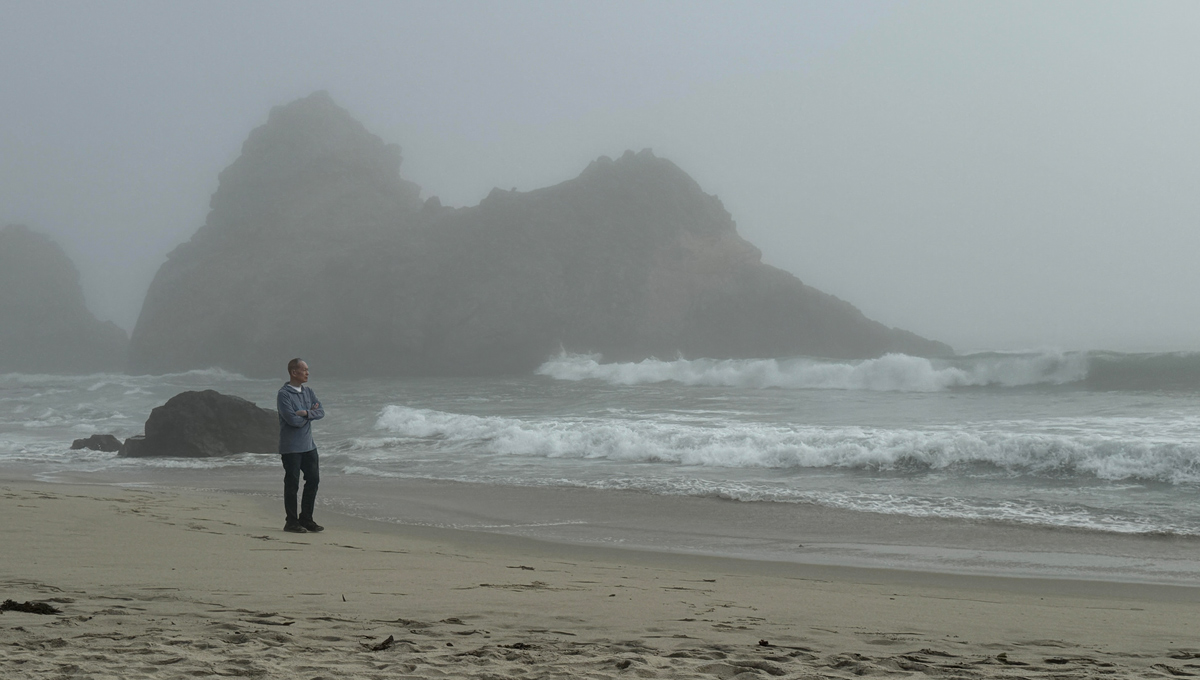
US Navy Rear Admiral Nguyen Huan looking out to sea at Big Sur, California during the filming of On Healing Lands, Birds Perch (Photo Courtesy Naja Pham Lockwood)
Admiral Huan had been interviewed previously. However, he was not immediately amenable to being in the film.
“He didn’t want to talk about the story. He had been asked [about it] and would comment. But he had never gone in this great depth. It is so painful, as you can see from the film.”
In order to convince Huan to participate in the filming, Pham Lockwood and her production team brought in one of the nation’s top psychologists on childhood trauma.
“Every step of the way, even deciding where we decided to film to help each with their own trauma. That was the reason why Huan was in Big Sur in the Redwoods and peace of nature. We were advised by our psychologist, and it helped a lot. If we had put him in a CNN studio with lights on top of him, I don’t think he could have told that story,” she said.
For the children of the Viet Cong, Pham Lockwood and her team had to go to Vietnam, ask permission, send questions in advance, and be approved.
“We didn’t want to hide anything. We wanted to be as clear and direct as possible,” she said. “They were very courageous and honest about their story. We worked really hard to cut through the politics.”
They did, however, have to mention the Tet Offensive.
“The story is really about how the children dealt with the decisions of the previous generation,” Pham Lockwood believes. “And how they move beyond the war. None of them are there yet, as we see. They are still dealing with their trauma. They are moving towards healing every day,” she says.
“None of these people have the money to go through therapy. This is their live therapy in their interview,” she adds. “I think you should think of this film as a journey towards healing. Maybe it will take their children’s generation to have complete reconciliation. I don’t see them coming together to have a kumbaya moment at this time because they’re still dealing with their own trauma. The journey is getting better, but it’s still horrifically painful for them after 50 years.”
At the same time, Pham Lockwood views the participants in the film as very brave.
“Only when we see the other side and their own journey of pain and suffering do we fully comprehend what it means for the Vietnam War,” Pham Lockwood adds.
In the end, Naja Pham Lockwood wants how she feels about photojournalism to be clear.
“I believe in the power of photojournalism. It was so during the War, and even more so now,” she says. “In our film, we wanted to bring forth [that] it’s really the civilians that are hurt the most by war.”
On Healing Land, Birds Perch succeeds brilliantly in that mission.
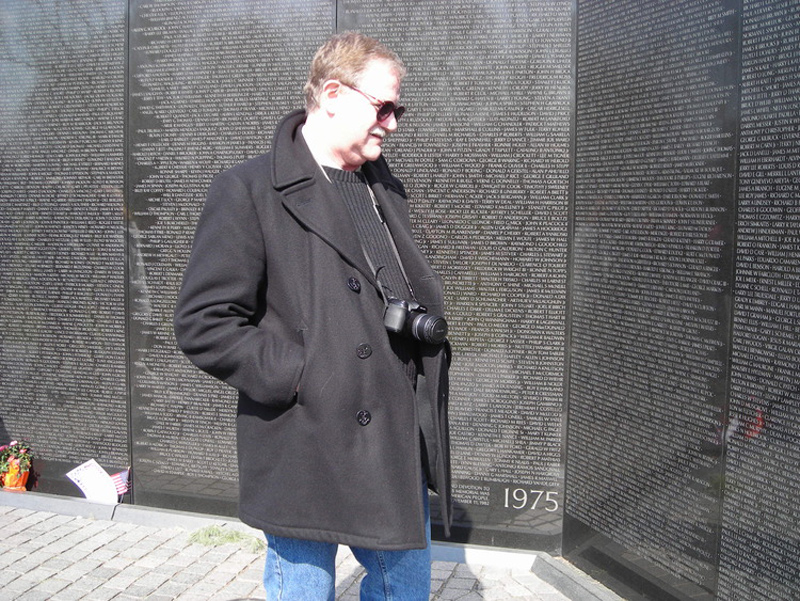
ABOUT THE AUTHOR — Marc Yablonka is a military journalist whose reportage has appeared in the U.S. Military’s Stars and Stripes, Army Times, Air Force Times, American Veteran, Vietnam magazine, Airways, Military Heritage, Soldier of Fortune and many other publications. He is the author of Distant War: Recollections of Vietnam, Laos and Cambodia, Tears Across the Mekong, Vietnam Bao Chi: Warriors of Word and Film, and Hot Mics and TV Lights: The American Forces Vietnam Network.
Between 2001 and 2008, Marc served as a Public Affairs Officer, CWO-2, with the 40th Infantry Division Support Brigade and Installation Support Group, California State Military Reserve, Joint Forces Training Base, Los Alamitos, California. During that time, he wrote articles and took photographs in support of Soldiers who were mobilizing for and demobilizing from Operation Iraqi Freedom and Operation Enduring Freedom.
His work was published in Soldiers, official magazine of the United States Army, Grizzly, magazine of the California National Guard, the Blade, magazine of the 63rd Regional Readiness Command-U.S. Army Reserves, Hawaii Army Weekly, and Army Magazine, magazine of the Association of the U.S. Army.
Marc’s decorations include the California National Guard Medal of Merit, California National Guard Service Ribbon, and California National Guard Commendation Medal w/Oak Leaf. He also served two tours of duty with the Sar El Unit of the Israeli Defense Forces and holds the Master’s of Professional Writing degree earned from the University of Southern California.
Leave A Comment